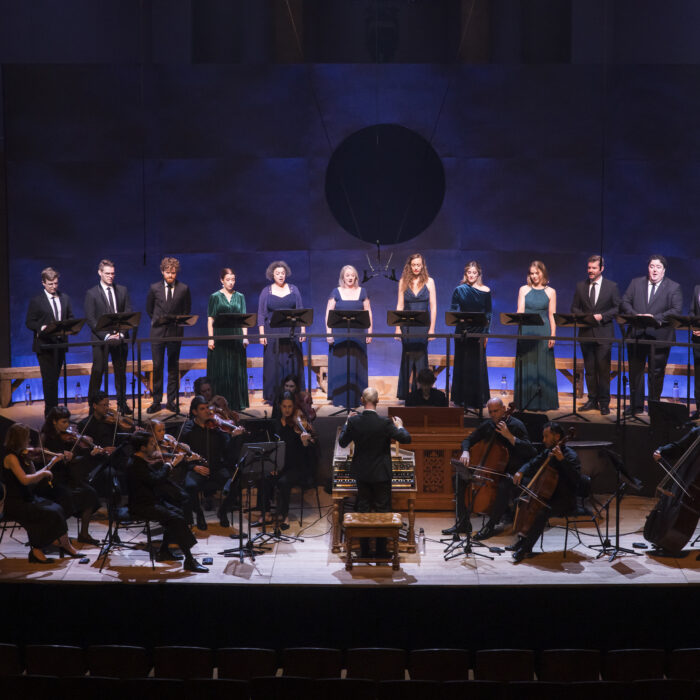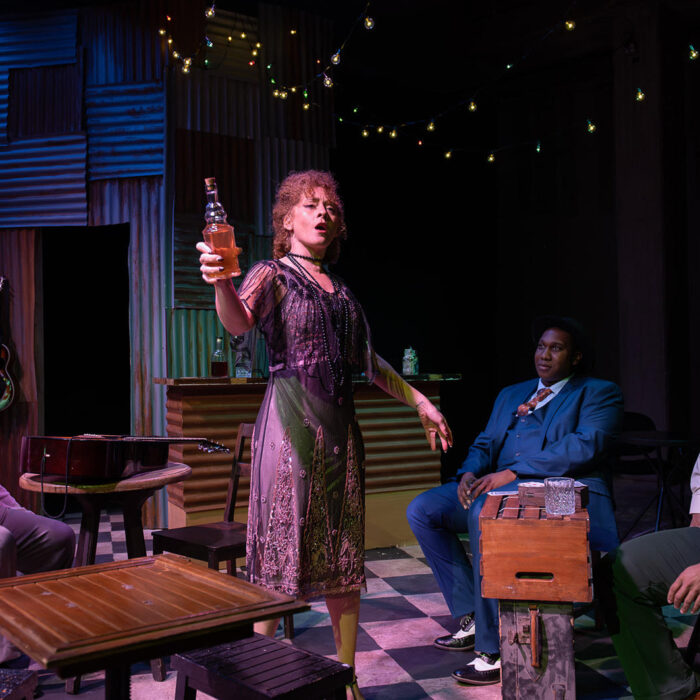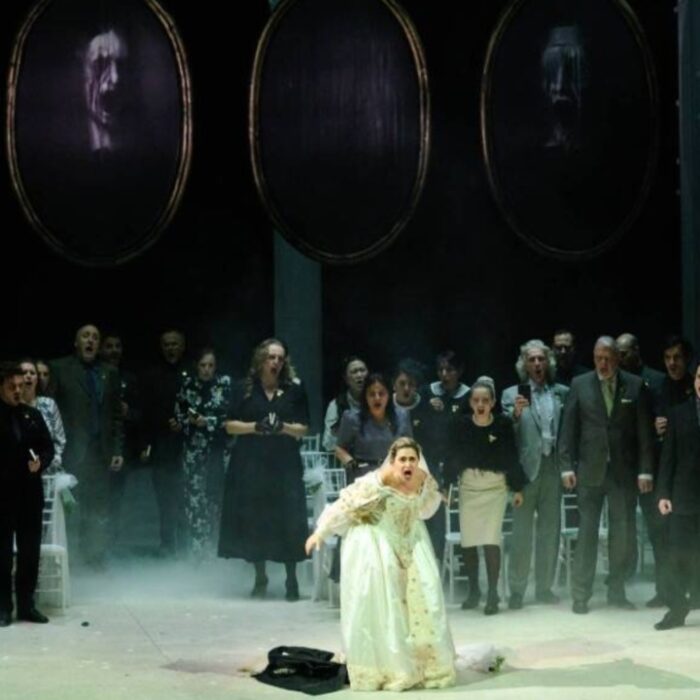
Teatro La Fenice 2024-25 Review: Tosca
Daniele Rustioni Leads Memorable Reading With an Unforgettable Chiara Isotton & Roberto Frontali
By Francisco Salazar(Photo: Michele Crosera)
On September 4, 2025 Teatro La Fenice showed the second to last performance of Puccini’s “Tosca.” The company is presenting a new production of Puccini’s masterpiece and reviving the work for the first time since 2019.
For this new production, the company has lined up an outstanding cast with a great conductor and a production that sets the work in a fascist society to bring the story into contemporary times.
The result was a thrilling musical experience with a stark production that could be muddled at times.
Thrilling Reading
The biggest highlight of the evening was without a doubt Daniel Rustioni. The Italian conductor has a way with the orchestra making it sound polished but at the same time expressive. He is able to pull many details forward without ever dragging the orchestra and most importantly he follows the singers to perfection. On this evening he brought the menacing colors in Act one as Scarpia entered the scene while he showcased a lighter and romantic timbre in the orchestra for Tosca and Cavaraodossi’s opening duet. The “Te Deum” was another highlight as the chorus blended well with the orchestra never covering Robert Frontali in the ensemble.
In Act two, Rustioni moved the music forward with propulsion and had the orchestra grow in sound as Puccini’s music took on threatening sounds and more dramatic weight. In the torture scene, the music started with a mezzo forte and eventually reached a fortissimo with brass section and timpani ringing out in full force. One could feel the tension building as Tosca’s lines rose to the highest extensions of her voice. The orchestra was in tandem with Chiara Isotton and created perfection in the scene. And then there was the timpani march that leads into the “Vissi d’arte.” The rhythm was ominous but as the music flowed into the soprano’s famed aria, it took on a lush sound filled with expressive colors. Same could be said for the “E luevan le stelle,” which emphasized the desperation of Cavaradossi’s pain with the violin’s crescendoing to a forte. The fanfare that opens the third act was also a highlight as it showcased an immaculate brass section that quickly transitioned to the nostalgic music that leads into Cavaradossi’s famed aria. The detail in each line was clear and Rustioni never drifted from the forward momentum nor did he ever indulge in slow tempi. The cello ensemble that leads into “E lucevan le stelle” was played with gorgeous lines with the cellists sliding into each note with expressive quality and bringing out the tragic feel to the music.
The final notes of the opera as Tosca jumped were also harrowing and impactful. The orchestra’s thunderous sound vibrated through the hall with immense sound even after the music had stopped.
Striking Prima-Donna
In the title role, Chiara Isotton was reprising her acclaimed portrayal which she sang at La Fenice in 2019. Isotton has a natural dramatic soprano voice that can easily go from a shimmering piano to a dramatic forte that resonates with power. On this evening, Isotton had a rocky start as she came in singing “Mario Mario Mario” with a slight wobble. That slowly disappeared as she sang in her middle voice and pulled back the sound bringing out a clear and bright timbre in her first duet. Her “non la sospiri la nostra casetta,” was sung a delicate legato line emphasizing her Tosca’s youthfulness but also her coquettish qualities. As the line slowly evolved and climaxed, her voice expanded and the sound obtained a sweet but strong vibrancy. Yet Isotton kept the voice back throughout the duet keeping the jealous outbursts under control and the climatic finale of the duet “se tu guardi al mio dolor” to a mezzo forte. The ensuing duet with Scarpia was also restrained and it felt like Isotton was trying to leave out all the clichés from her interpretation. While she did seem to be affected by Roberto Frontali’s Scarpia and the suggestion that her Cavaradossi was cheating on her, Isotton kept the lines in a mezzo voce never overly emotionalizing anything. Her final, “dio mi perdona” was filled with dignified sound rather than that suggesting tears. This was a Tosca who would not be fooled so easily. And while it sometimes felt too restrained, it worked.
In Act two, that calmed and restrained energy was finally pushed to the limit and Isotton’s Tosca fully unleashed the fury she had been keeping in during the first act. As she entered the second act, Isotton had a regal presence that slowly started to unravel. Her first “non so nulla” were sung with a weighty chest voice that emphasized authority and control but as Frontali’s Scarpia started to torture her, Isotton’s voice gained power and force. The cries for help as she rose to her High Cs were incredibly forceful and each time, her notes emphasized Tocsa’s desperation. Her lower notes in “Io son io che cosi torturate!” were particularly memorable as she dug into her massive chest voice bringing out the hopelessness in her character. In “Vissi D’arte,” Isotton returned to that restrained color keeping the aria more of an internalized prayer. The legato lines floated with a gorgeous piano that slowly crescendoed to the “perche, signore” which she held for a few bars before descending the line and ending with a shimmering piano. But Isotton’s fury would return toward the end of the act as she murdered her Scarpia. Here Isotton emoted the lines “Questo è il bacio di Tosca” and “Ti Soffoca il Sangue!” with fierce accents as she leaned into each word with such preciseness. Her anger quickly turned to fear as she washed her hands off and then put Scarpia’s body into a car before slowly sitting in the car in anguish.
In Act three, Isotton arrived with a triumphant youthful energy. But, as she saw the Angel of Death depicted in this production there was noticeable fear in her visage. That said, her voice brought youthful qualities while combining them with nostalgia and grit. In “Il tuo sangue o il mio amore voltea,” Isotton brought her full voice with a heroic quality that soon turned to despair and fear as she depicted Scarpia’s death. But she slowly brought back that bright timbre in “Amor che seppe a te vita serbare” and ended the duet with a triumphant “Armonie di colore” that ascended to potent high notes that she combined beautifully with Riccardo Massi. Both voices resounded with great power into the hall, and received a great ovation before they finished “dell’estasi d’amore.” After realizing that Cavaradossi had been murdered, Isotton ran up the stairs in this production and looked around completely trapped and ran upstage before singing a glorious “O Scarpia, avanti a dio!” and jumping off forcefully. It was striking and among the best finales I have ever seen in a Tosca.
Isotton received a well deserved ovation at the end during her curtain call. And all I can say is this is a “Tosca” audiences must see.
A Legend Still Has It
As Scarpia, veteran baritone Roberto Frontali was terrifying. At the age of 67, he retains a refined sound that can ride over the largest ensembles. His diction is perfection, each word getting the emphasis needed. And his presence is imposing. The moment he walked on stage and sang “un tal baccano in chiesa,” his voice boomed into the auditorium with authority and an ominous presence. His ensuing duet with Tosca, saw the baritone sing with a suave timbre that emphasized this Scarpia’s calculating qualities while in the “Te Deum,” he stood downstage and let his full voice out, singing over the chorus. His Scarpia was contained but you could hear in his voice, the desire for Tosca as he sang “Tosca mi far dimenticare iddio.”
That desire grew in Act two as he began “Tosca è un buon falco” and later “Ha piu forte sappore.” The baritone sang with flowing lines and as he went up to the higher extension of the voice, he emphasized the lustful qualities of his Scarpia. His voice grew in volume and he began emoting certain phrases to emphasize those emotions. But in other moments especially at the beginning of his exchange with Tosca he began with a suave vocal delivery, emphasizing this Scarpia’s sarcasm. This slowly built a commanding darker timbre in his delivery of “Aprite le porte” and as he repeated “Piu forte,” one could feel his menacing qualities. But later he went back to that refined sound in “Gia- Mi dicon venal, ma a donna bella non mi vendo.” But Frontali couldn’t hold back as he rose to the higher notes and as he ended the aria, his “Mia!” and “Ti Voglio” became more aggressive and lecherous. Physically Frontali also began a cat and mouse chase with Isotton looming over her at every moment as he moved around a car on stage, never leaving her visage. The movements became even more violent as the act evolved eventually taking Isotton by force. Isotton and Frotali brought violence to the scene in an organic way and once his Scarpia was murdered one could feel relief.
Strong Support
In the role of Cavaradossi, Riccardo Massi sang with an exquisite sound and gorgeous phrases. His “Recondita Armonia” brought out refined legato lines that flowed one into the next and an array of dynamics from a piano to a heroic forte sound in his climactic “Tosca sei tu.” “E lucevan le stelle” also showcased that elegance in his singing. He opened his phrases with a tender piano that emphasized the nostalgia and sadness of his character. And as the aria continued to build, so did his sound, starting with “Oh! Dolci baci” and eventually crescendoing to “E non ho amato mai tanto la vita!” with incredible smoothness but also accenting “la vita!” emphasizing that desperation in the character. Still Massi seemed to be way too refined and restrained for Cavaradossi. The tenor has an immense sound that is clearly controlled but one could feel he was holding back and covering way too much. That was clearest in “Vittoria! Vittoria!” as Massi’s timbre was resonant in the heroic line, but it was too contained to create an impact. The same could be said of his stage presence as he was a bit stiff in the first act and in the second act, too subdued.
His approach worked best in his duets with Isotton as he displayed that refined quality singing with beautiful sound especially in “O dolci mani,” “amaro sol per the m’era moire” and “Qualche Occhi al mondo.” He was a good foil to Isotton’s fiery Tosca and that created a great contrast in their scenes.
As Spoletta, Cristiano Olivieri was terrifying bringing a solid tenor to his crucial role. Matteo Peirone sang the Sagrestano with comic timing and in his brief scene with Scarpia he showcased a darker sound in his rugged but resonant timbre. He made an appearance in the third act showcasing a character filled with guilt for betraying Cavaradossi. Mattia Denti was also fantastic as Angelotti bringing a booming bass to the stage.
Totalitarian Society
The biggest issue of the evening was Joan Anton Rechi‘s fifties set production. In the production notes, the director says he decided to set the opera in a nameless dictatorship in the fifties and show the fear that can be caused in a totalitarian society. Rechi also noted that he believed that the opera was about freedom and therefore decided to set the opera in outdoor spaces instead of the usual indoor locations that the opera was written for. The production has unique flourishes of directing like the fact that Scarpia is always surrounded by his entourage of goons and when Tosca reenters the scene in Act one, she is surrounded by these men who ogle her. Then in the ensuing duet with Scarpia, he is always on a staircase looking down at Tosca emphasizing the power dynamics between the two. Another interesting element in the production is the third act’s staircase which leads nowhere and which seems more like a maze that entraps the characters in their environment. One can immediately understand Tosca’s decision to jump in order to escape, and thus break free from the society she is in.
The stark environments and the use of darker colors also helped create that dark and ominous aesthetic that one is used to seeing when a totalitarian society is depicted.
However, the rest of the production is a bit difficult to understand. The first act is set outside of a church where you see a door undergoing restoration. A huge scaffolding surrounds the set creating a lack of space that forced the singers downstage. The lack of depth did not help the singers with blocking and for the most part they were either uncomfortably climbing staircases as they sang or standing in one spot. It created a bland and stale first act that lacked any dynamic interactions with between Tosca and Cavaradossi or between Tosca and Scarpia. Only in the “Te Deum,” where the doors open up to reveal a courtyard, did the set feel it had some depth but even then the blocking was uninteresting.
The second act which is set outside Scarpia’s house was not clear. As I watched the production I thought it was a theater where Tosca was performing but upon reading the program notes, I discovered the real location which clarified things a little. Still, I shouldn’t have to read a program to understand a concept. My biggest qualms with the second act was once again the lack of dynamism in the set. Most of the action ended up downstage and in a cat and mouse between Tosca and Scarpia around a car. The car was beautiful to look at, but sometimes seemed like a distraction. That car is what Tosca runs off in at the end, though it never moves on the stage and it creates an acoustic nightmare for Scarpia’s opening lines of the act. Then there were some random ladies who enter the house with some random men and I could not tell you what the purpose of those women were. I thought they were going to a performance but apparently they were going to a party at Scarpia’s house. Who they were and what their purpose was baffled me and was a distraction for the action at the fore.
The other biggest issue was attempting to force elements into the scene that Puccini clearly wrote into the text. Why do Scarpia’s henchmen have a wooden box outside? Is it because Scarpia sings “Sedette” to Cavaradossi so therefore they need something to justify it. Then why does someone randomly bring out a bottle of wine for Scarpia before his aria? Is it to justify the text “la povera mia cena fu interrotta?” And why does that bottle come with a knife? Is it just there to plant it for Tosca to kill Scarpia. I know it’s opera and it’s our job to take ourselves out of reality but perhaps it would have been less questionable if the elements seemed to come in organically and not forced.
The third act also introduced elements that seemed out of place with the realism of the first two. The introduction of an “angel of death” seemed to be a random touch that Tosca sees and clearly fears. Yet, it just seemed thrown in without any pay off and set up a surrealist touch that was nowhere in the entire production.
Overall this was a memorable evening thanks to Daniele Rustioni, Chiara Isotton and Roberto Frontali’s committed performances.


